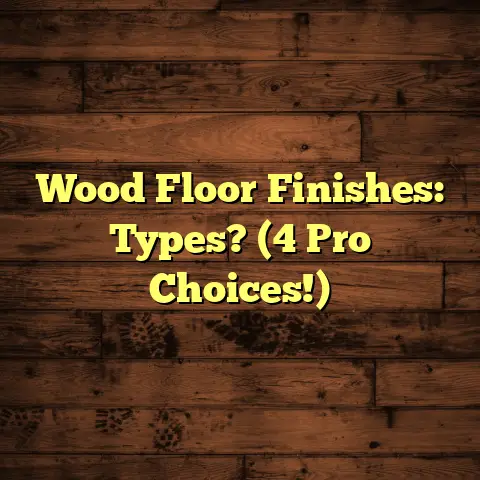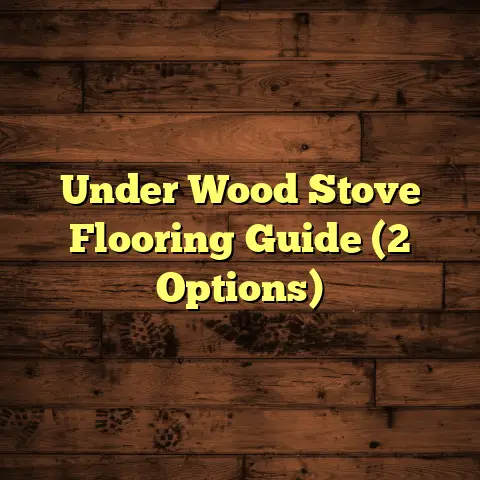Vinyl Wood Flooring From Floor & Decor (3 Install Fails!)
Remember the smell of sawdust, the rhythmic tap-tap-tapping of a hammer, and the feeling of accomplishment after transforming a room?
I do.
Growing up, home improvement projects were family affairs.
My dad, a weekend warrior with more enthusiasm than expertise, always involved us in his grand schemes.
Flooring was a frequent battlefield, and while we often ended up with crooked tiles or slightly off-kilter baseboards, we also created memories.
Fast forward to today, and flooring options have exploded.
We’ve moved far beyond linoleum and shag carpet.
Vinyl wood flooring has become a top contender, offering the look of hardwood with added durability and affordability.
Floor & Decor has emerged as a major player, attracting homeowners with its vast selection and competitive prices.
But here’s the thing: even with the best materials, installation can be tricky.
I’ve seen firsthand how easily things can go wrong, and I’m here to share some hard-earned wisdom.
Let’s dive into three vinyl wood flooring install fails I’ve witnessed (and sometimes participated in!), all involving materials from Floor & Decor.
Hopefully, my experiences will help you avoid similar headaches.
Section 1: The Allure of Vinyl Wood Flooring
1.1: What is Vinyl Wood Flooring?
Okay, let’s get down to brass tacks.
What exactly is vinyl wood flooring?
Basically, it’s a synthetic flooring option designed to mimic the appearance of real wood.
Think of it as a high-tech impersonator.
It typically consists of multiple layers: a backing layer for stability, a core layer for durability, a printed design layer that provides the wood look, and a top wear layer for protection.
This wear layer is crucial, as it determines how well the flooring resists scratches, dents, and stains.
You’ll often see it measured in mils (thousandths of an inch).
A thicker wear layer (12 mil or higher) is generally recommended for high-traffic areas.
Why is vinyl wood flooring so popular?
Well, it boasts several advantages over traditional hardwood.
- Durability: It can withstand a lot of abuse.
- Water Resistance: A game-changer for kitchens and bathrooms.
- Ease of Maintenance: Forget sanding and refinishing; just sweep and mop.
- Cost-Effectiveness: Generally more affordable than hardwood.
According to Statista, the resilient flooring market, which includes vinyl, has seen steady growth, projected to reach over $40 billion globally by 2027.
That’s a lot of vinyl!
1.2: Why Floor & Decor?
So, why do so many people flock to Floor & Decor for their vinyl wood flooring needs?
Several reasons jump to mind.
First and foremost, their selection is massive.
They offer a seemingly endless array of styles, colors, and textures.
Whether you’re after a rustic farmhouse look or a sleek modern vibe, you’re likely to find something that catches your eye.
Secondly, their pricing is competitive.
They often run promotions and offer volume discounts, making them an attractive option for budget-conscious homeowners.
Thirdly, they have a strong presence.
With stores across the country, they’re easily accessible.
They also offer online ordering and in-store pickup, providing flexibility for shoppers.
I’ve personally worked with Floor & Decor on several projects.
I appreciate their knowledgeable staff, who are usually willing to help you navigate the vast selection and answer your questions.
However, I’ve also heard mixed reviews about their customer service after the sale.
Some customers have reported difficulties with returns or warranty claims.
Here’s a quick anecdote:
I had a client who purchased a large quantity of vinyl plank flooring from Floor & Decor.
Unfortunately, a few boxes arrived damaged.
While the store eventually resolved the issue, it took several phone calls and emails to get the replacement planks.
The lesson?
Always inspect your materials carefully upon arrival, and document any damage immediately.
Section 2: The Importance of Proper Installation
2.1: The Basics of Vinyl Wood Flooring Installation
Alright, let’s talk about the nitty-gritty of installation.
While vinyl wood flooring is often touted as a DIY-friendly option, proper installation is key to achieving a professional-looking and long-lasting result.
Here’s a simplified overview of the process:
- Surface Preparation: This is arguably the most important step. The subfloor must be clean, level, and dry. Any imperfections, such as cracks or unevenness, need to be addressed.
- Acclimation: Allow the vinyl planks to acclimate to the room’s temperature and humidity for at least 48 hours before installation. This helps prevent expansion and contraction issues later on.
- Layout Planning: Determine the best starting point and the direction in which the planks will be laid. Consider factors such as the room’s shape, the location of doorways, and the desired aesthetic.
- Installation: Depending on the type of vinyl flooring (e.g., click-lock, glue-down), follow the manufacturer’s instructions carefully. Use spacers to maintain consistent expansion gaps around the perimeter of the room.
- Finishing Touches: Install baseboards, transition strips, and other finishing elements to complete the look.
As for tools, you’ll typically need:
- Measuring tape
- Utility knife
- Straight edge
- Tapping block
- Rubber mallet
- Spacers
For glue-down installations, you’ll also need adhesive, a trowel, and a roller.
2.2: Common Installation Pitfalls
Why is proper installation so crucial?
Because a botched job can lead to a whole host of problems down the road.
I’m talking about:
- Warping: Uneven surfaces or improper acclimation can cause the planks to warp and buckle.
- Uneven Surfaces: A poorly prepared subfloor will result in an uneven finished floor.
- Gaps: Misaligned planks or insufficient expansion gaps can create unsightly gaps between the planks.
- Peeling (Glue-Down): Using the wrong adhesive or applying it incorrectly can cause the planks to peel up.
- Reduced Lifespan: Poor installation can compromise the durability of the flooring, shortening its lifespan.
According to the National Wood Flooring Association (NWFA), improper subfloor preparation is a leading cause of flooring failures.
I’ve seen this firsthand on countless occasions.
I once had to rip up an entire vinyl floor because the homeowner had failed to level the subfloor properly.
It was a costly and time-consuming mistake that could have been easily avoided with proper preparation.
Section 3: Install Fail #1 – The Uneven Surface Disaster
3.1: Case Study
Let’s call our homeowner Sarah.
Sarah was thrilled to finally renovate her outdated kitchen.
She envisioned a bright, modern space with beautiful vinyl wood flooring from Floor & Decor.
She chose a stylish gray-toned plank that she thought would perfectly complement her new cabinets and countertops.
Sarah, being a self-proclaimed DIY enthusiast, decided to tackle the installation herself.
She watched a few YouTube videos, gathered her tools, and dove in.
However, Sarah overlooked one crucial detail: the subfloor.
Her kitchen subfloor was far from perfect.
It had several noticeable dips and bumps, remnants of previous flooring installations.
Instead of leveling the subfloor with a self-leveling compound, Sarah decided to proceed with the installation, hoping that the vinyl planks would somehow magically even things out.
Big mistake.
As she laid the planks, she quickly realized that the uneven subfloor was causing the planks to rock and shift.
Some planks were noticeably higher than others, creating an uneven and unstable surface.
3.2: Consequences
The consequences of Sarah’s uneven surface disaster were significant.
Aesthetically, the floor looked terrible.
The unevenness was immediately noticeable, especially in areas where the light hit the floor at an angle.
Functionally, the floor was a hazard.
Sarah tripped several times on the uneven planks, and she worried about her elderly mother, who visited frequently.
Furthermore, the unevenness put stress on the planks, causing them to flex and potentially crack over time.
Sarah’s dream kitchen renovation had turned into a nightmare.
She was left with an unsightly and unsafe floor that needed to be completely ripped up and reinstalled.
3.3: Lessons Learned
The biggest lesson from Sarah’s experience is the critical importance of surface preparation.
I can’t stress this enough.
A level and stable subfloor is the foundation for a successful vinyl wood flooring installation.
Before you even think about laying the first plank, thoroughly inspect your subfloor.
Use a level to identify any unevenness.
If you find dips or bumps, address them with a self-leveling compound or shims.
Don’t try to cut corners or hope that the vinyl planks will magically fix the problem.
It won’t happen.
In Sarah’s case, spending a few extra hours leveling the subfloor would have saved her a tremendous amount of time, money, and frustration in the long run.
Here’s a statistic to chew on:
According to a study by the American Society of Interior Designers (ASID), poor subfloor preparation is responsible for up to 30% of all flooring failures.
That’s a staggering number!
Section 4: Install Fail #2 – Misaligned Planks
4.1: Case Study
Meet David.
David, a meticulous engineer, prided himself on his attention to detail.
He approached his vinyl wood flooring installation with a spreadsheet, a laser level, and a determination to achieve perfection.
He purchased a beautiful, dark-stained vinyl plank flooring from Floor & Decor, envisioning a sophisticated and elegant living room.
David meticulously measured his living room and carefully planned the layout of the planks.
He wanted to create a seamless and visually appealing floor with minimal waste.
However, despite his best efforts, David encountered a major problem: misaligned planks.
As he progressed with the installation, he noticed that the planks were gradually drifting out of alignment.
The parallel lines that he had so carefully established were starting to veer off course.
He tried to correct the misalignment by adjusting the planks, but the problem persisted.
The more he tried to fix it, the worse it seemed to get.
4.2: Consequences
The consequences of David’s misaligned planks were both aesthetic and functional.
Visually, the misaligned planks created a jarring and unprofessional look.
The once-seamless floor now appeared crooked and uneven.
The misalignment was particularly noticeable along the edges of the room, where the planks butted up against the walls.
Functionally, the misaligned planks created gaps and uneven seams.
These gaps were not only unsightly but also prone to collecting dirt and debris.
Furthermore, the uneven seams made it difficult to clean the floor properly.
David’s dream of a sophisticated living room had turned into a frustrating and disappointing reality.
He was left with a floor that looked amateurish and required constant maintenance.
4.3: Lessons Learned
David’s experience highlights the importance of careful measurement and planning in the installation process.
While meticulousness is admirable, it’s crucial to understand the nuances of vinyl wood flooring installation.
Here are a few key takeaways:
- Start with a Straight Line: Use a laser level or a chalk line to establish a perfectly straight starting line. This will serve as your reference point for the entire installation.
- Check Alignment Frequently: As you lay each row of planks, constantly check the alignment with your starting line. Use a straight edge to ensure that the planks are running parallel.
- Use Spacers Consistently: Maintain consistent expansion gaps around the perimeter of the room using spacers. This will allow the floor to expand and contract without buckling or warping.
- Don’t Force the Planks: If a plank doesn’t fit properly, don’t force it. Instead, carefully examine the alignment and make any necessary adjustments.
A small misalignment early in the installation can compound over time, leading to a major problem down the road.
Remember the old adage: measure twice, cut once.
In this case, it should be: measure thrice, align constantly.
Section 5: Install Fail #3 – Adhesive Nightmares
5.1: Case Study
Let’s talk about Emily.
Emily decided to install glue-down vinyl plank flooring in her basement.
She chose a warm, inviting wood-look vinyl from Floor & Decor, hoping to create a cozy and functional living space.
Emily carefully researched the installation process and purchased what she thought was the appropriate adhesive.
However, she made a critical mistake: she didn’t read the manufacturer’s instructions thoroughly.
She assumed that all adhesives were created equal and that any general-purpose adhesive would work just fine.
She spread the adhesive liberally across the subfloor and began laying the vinyl planks.
Initially, everything seemed to be going well.
The planks adhered to the subfloor without any problems.
However, after a few weeks, Emily noticed that some of the planks were starting to peel up at the edges.
She tried to re-adhere the planks with more adhesive, but the problem persisted.
The peeling became more widespread, and soon, large sections of the floor were coming loose.
5.2: Consequences
The consequences of Emily’s adhesive nightmare were severe.
The peeling planks created an unsightly and unstable floor.
The loose planks were a tripping hazard, and they also made it difficult to clean the floor.
Furthermore, the peeling adhesive created a sticky and unpleasant residue that attracted dirt and debris.
Emily’s basement renovation had turned into a sticky, peeling mess.
She was left with a floor that needed to be completely ripped up and reinstalled.
5.3: Lessons Learned
Emily’s experience underscores the importance of following manufacturer guidelines and selecting the appropriate adhesive for the specific vinyl wood flooring being installed.
Adhesive is not a one-size-fits-all product.
Different types of vinyl flooring require different types of adhesives.
Using the wrong adhesive can lead to a variety of problems, including:
- Peeling: The adhesive may not bond properly to the vinyl planks or the subfloor, causing the planks to peel up.
- Bubbling: The adhesive may trap air bubbles under the planks, creating an uneven and unsightly surface.
- Damage to the Flooring: Some adhesives can react with the vinyl planks, causing them to discolor or degrade.
Always read the manufacturer’s instructions carefully before selecting an adhesive.
Pay attention to the recommended adhesive type, the application method, and the drying time.
If you’re unsure which adhesive to use, consult with a flooring professional.
They can help you choose the right adhesive for your specific vinyl flooring and subfloor.
Section 6: Reflections and Moving Forward
6.1: Building on Experience
These three stories, Sarah’s uneven surface, David’s misaligned planks, and Emily’s adhesive nightmare, represent just a fraction of the potential pitfalls that can arise during vinyl wood flooring installation.
They highlight the importance of:
- Thorough Preparation: Don’t underestimate the importance of surface preparation. A level, clean, and dry subfloor is essential for a successful installation.
- Careful Planning: Take the time to plan the layout of the planks and establish a straight starting line.
- Following Instructions: Read and follow the manufacturer’s instructions carefully, especially when it comes to adhesive selection and application.
- Seeking Professional Help: Don’t be afraid to seek professional help if you’re unsure about any aspect of the installation process.
Learning from these mistakes can save you time, money, and frustration.
6.2: The Future of Vinyl Flooring
The future of vinyl wood flooring looks bright.
Innovations in manufacturing technology are leading to more realistic and durable products.
New installation methods, such as click-lock systems, are making it easier for homeowners to achieve professional-looking results.
Floor & Decor is likely to remain a popular choice for homeowners seeking affordable and stylish vinyl wood flooring options.
By learning from the experiences of others and taking the necessary precautions, you can avoid common installation pitfalls and create a beautiful and long-lasting floor that you’ll enjoy for years to come.
Conclusion
As we come to the end of this journey through vinyl wood flooring installation fails, I hope you’ve gained some valuable insights and practical advice.
Remember the warmth of those childhood home improvement projects?
The slightly crooked picture frames, the paint splatters on the floor, and the sense of accomplishment after a job well done (or at least attempted!).
Home improvement is a journey, not a destination.
There will be successes and failures along the way.
The key is to learn from your mistakes, embrace the challenges, and never stop creating spaces that reflect your personality and style.
Even the most challenging projects can lead to beautiful, cherished spaces filled with memories.
So, go forth and create!
Just remember to level that subfloor.





